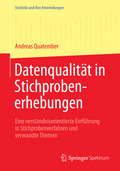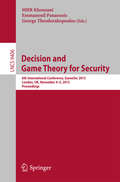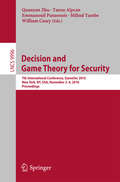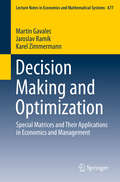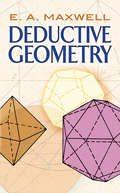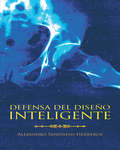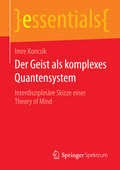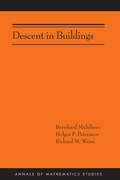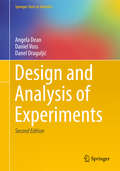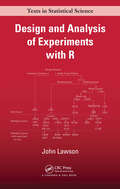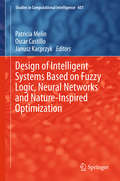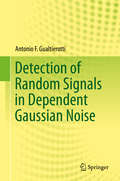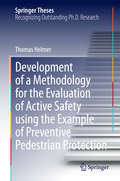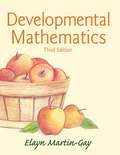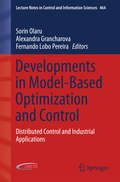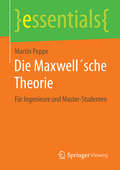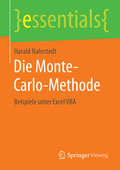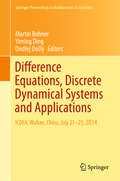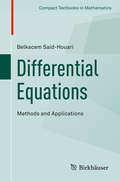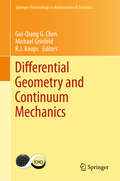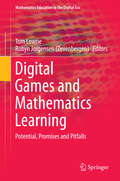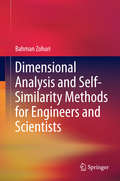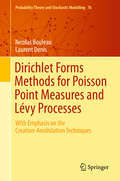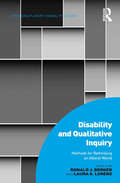- Table View
- List View
Datenqualität in Stichprobenerhebungen: Eine verständnisorientierte Einführung in Stichprobenverfahren und verwandte Themen (Statistik und ihre Anwendungen)
by Andreas QuatemberDas Buch bietet eine verständnis- und anwendungsorientierte Einführung in verschiedene Stichprobendesigns, bestehend aus Auswahlverfahren und Schätzmethodik. Das Methodenverständnis wird unterstützt durch einfach nachvollziehbare und gerade dadurch besonders förderliche Beispiele. Dabei werden auch andere praxisrelevante Aspekte, welche sich auf die Qualität der gezogenen Schlussfolgerungen auswirken, nicht ausgeklammert: Behandelt werden unter anderem die Nonresponse-Thematik sowie die Anwendung von nichtzufälligen Auswahltechniken wie dem Quotenverfahren.
Decision and Game Theory for Security
by Mhr Khouzani Emmanouil Panaousis George TheodorakopoulosThis book constitutes the refereed proceedings of the 6th International Conference on Decision and Game Theory for Security, GameSec 2015, held in London, UK, in November 2015. The 16 revised full papers presented together with 5 short papers were carefully reviewed and selected from 37 submissions. Game and decision theory has emerged as a valuable systematic framework with powerful analytical tools in dealing with the intricacies involved in making sound and sensible security decisions. For instance, game theory provides methodical approaches to account for interdependencies of security decisions, the role of hidden and asymmetric information, the perception of risks and costs in human behaviour, the incentives/limitations of the attackers, and much more. Combined with our classical approach to computer and network security, and drawing from various fields such as economic, social and behavioural sciences, game and decision theory is playing a fundamental role in the development of the pillars of the "science of security".
Decision and Game Theory for Security
by Quanyan Zhu Tansu Alpcan Emmanouil Panaousis Milind Tambe William CaseyThis book constitutes the refereed proceedings of the 6th International Conference on Decision and Game Theory for Security, GameSec 2015, held in London, UK, in November 2015. The 16 revised full papers presented together with 5 short papers were carefully reviewed and selected from 37 submissions. Game and decision theory has emerged as a valuable systematic framework with powerful analytical tools in dealing with the intricacies involved in making sound and sensible security decisions. For instance, game theory provides methodical approaches to account for interdependencies of security decisions, the role of hidden and asymmetric information, the perception of risks and costs in human behaviour, the incentives/limitations of the attackers, and much more. Combined with our classical approach to computer and network security, and drawing from various fields such as economic, social and behavioural sciences, game and decision theory is playing a fundamental role in the development of the pillars of the "science of security".
Decision Making and Optimization
by Martin Gavalec Jaroslav Ramík Karel ZimmermannThe book is a benefit for graduate and postgraduate students in the areas of operations research, decision theory, optimization theory, linear algebra, interval analysis and fuzzy sets. The book will also be useful for the researchers in the respective areas. The first part of the book deals with decision making problems and procedures that have been established to combine opinions about alternatives related to different points of view. Procedures based on pairwise comparisons are thoroughly investigated. In the second part we investigate optimization problems where objective functions and constraints are characterized by extremal operators such as maximum, minimum or various triangular norms (t-norms). Matrices in max-min algebra are useful in applications such as automata theory, design of switching circuits, logic of binary relations, medical diagnosis, Markov chains, social choice, models of organizations, information systems, political systems and clustering. The input data in real problems are usually not exact and can be characterized by interval values.
Deductive Geometry (Dover Books on Mathematics)
by E. A. MaxwellThis concise review examines the geometry of the straight line, circle, plane, and sphere as well as their associated configurations, including the triangle and the cylinder. Aimed at university undergraduates, the treatment is also useful for advanced students at the secondary level.The straightforward approach begins with a recapitulation of previous work on the subject, proceeding to explorations of advanced plane geometry, solid geometry with some reference to the geometry of the sphere, and a chapter on the nature of space, including considerations of such properties as congruence, similarity, and symmetry. The text concludes with a brief account of the elementary transformations of projection and inversion. Numerous examples appear throughout the book.
Defensa del diseño inteligente
by Alejandro SanvisensLa teoría del diseño inteligente considera que la estructura de la materia, del cosmos y de los seres vivos manifiesta un diseño, un proyecto concebido por una inteligencia divina. <P><P>En este libro se dan a conocer los principales indicios de este diseño a través de la complejidad de los seres vivos, del origen de la vida, de la estructura y las leyes de la materia y del desarrollo cósmico. Se defiende la teoría del diseño inteligente de los ataques que ha recibido por parte de los principales representantes del ateísmo contemporáneo.
Der Geist als komplexes Quantensystem: Interdisziplinäre Skizze einer Theory of Mind (essentials)
by Imre KoncsikImre Koncsik beschreibt die Theorie des Geistes als naturphilosophische Theorie auf Basis der Physik. Er identifiziert signifikante Parallelen zwischen Geist und Gehirn, die beide durch Elemente der Quantentheorie und der komplexen Systemtheorie beschrieben werden können. Beide Theorien beziehen sich auf eine immaterielle, formale und imaginäre Schicht der Realität. Sie ermöglichen eine innovative Beschreibung der morphologischen Strukturen und dynamischen Aktivitätsmuster des Gehirns in Analogie zu Mustern des Geistes. Eine Theorie des Geistes bildet hinsichtlich ihrer technologischen Applikation den Grundstein einer neuen, im eigentlichen Sinn ,,intelligenten" Technologie: der quantenbasierten Systemtechnologie.
Descent in Buildings (AM-190)
by Bernhard Mühlherr Holger P. Petersson Richard M. WeissDescent in Buildings begins with the resolution of a major open question about the local structure of Bruhat-Tits buildings. The authors then put their algebraic solution into a geometric context by developing a general fixed point theory for groups acting on buildings of arbitrary type, giving necessary and sufficient conditions for the residues fixed by a group to form a kind of subbuilding or "form" of the original building. At the center of this theory is the notion of a Tits index, a combinatorial version of the notion of an index in the relative theory of algebraic groups. These results are combined at the end to show that every exceptional Bruhat-Tits building arises as a form of a "residually pseudo-split" Bruhat-Tits building. The book concludes with a display of the Tits indices associated with each of these exceptional forms.This is the third and final volume of a trilogy that began with Richard Weiss' The Structure of Spherical Buildings and The Structure of Affine Buildings.
Design and Analysis of Experiments
by Angela Dean Daniel Voss Danel DraguljićHandbook of Design and Analysis of Experiments provides a detailed overview of the tools required for the optimal design of experiments and their analyses. The handbook gives a unified treatment of a wide range of topics, covering the latest developments. This carefully edited collection of 25 chapters in seven sections synthesizes the state of the art in the theory and applications of designed experiments and their analyses. Written by leading researchers in the field, the chapters offer a balanced blend of methodology and applications. The first section presents a historical look at experimental design and the fundamental theory of parameter estimation in linear models. The second section deals with settings such as response surfaces and block designs in which the response is modeled by a linear model, the third section covers designs with multiple factors (both treatment and blocking factors), and the fourth section presents optimal designs for generalized linear models, other nonlinear models, and spatial models. The fifth section addresses issues involved in designing various computer experiments. The sixth section explores "cross-cutting" issues relevant to all experimental designs, including robustness and algorithms. The final section illustrates the application of experimental design in recently developed areas. This comprehensive handbook equips new researchers with a broad understanding of the field's numerous techniques and applications. The book is also a valuable reference for more experienced research statisticians working in engineering and manufacturing, the basic sciences, and any discipline that depends on controlled experimental investigation.
Design and Analysis of Experiments with R
by John LawsonDesign and Analysis of Experiments with R presents a unified treatment of experimental designs and design concepts commonly used in practice. It connects the objectives of research to the type of experimental design required, describes the process of creating the design and collecting the data, shows how to perform the proper analysis of the data,
Design and Development of Training Games
by Talib S. Hussain Susan L. ColemanThe multidisciplinary nature of learning-games development is key to successful projects. In this book, field leaders in serious games and professionals in entertainment games share practical guidelines and lessons from their own experiences researching and developing learning games. This volume includes: • The key elements of design and development that require particular attention from multiple disciplines to ensure success • An overview of successful models and methods, and the trade-offs made throughout the process, to guide development • Cohesive, multidisciplinary views of the issues that arise and of the techniques applied in order to produce effective learning games grounded in specific experiences, community consensus, and analysis of successful learning games that have already been released • The stories behind the games, to illustrate how final design and development decisions were reached. Aimed at professionals and academics interested in developing and researching learning games, it offers a comprehensive picture of the state of the art.
Design of Intelligent Systems Based on Fuzzy Logic, Neural Networks and Nature-Inspired Optimization
by Patricia Melin Oscar Castillo Janusz KacprzykThis book presents recent advances on the design of intelligent systems based on fuzzy logic, neural networks and nature-inspired optimization and their application in areas such as, intelligent control and robotics, pattern recognition, time series prediction and optimization of complex problems. The book is organized in eight main parts, which contain a group of papers around a similar subject. The first part consists of papers with the main theme of theoretical aspects of fuzzy logic, which basically consists of papers that propose new concepts and algorithms based on fuzzy systems. The second part contains papers with the main theme of neural networks theory, which are basically papers dealing with new concepts and algorithms in neural networks. The third part contains papers describing applications of neural networks in diverse areas, such as time series prediction and pattern recognition. The fourth part contains papers describing new nature-inspired optimization algorithms. The fifth part presents diverse applications of nature-inspired optimization algorithms. The sixth part contains papers describing new optimization algorithms. The seventh part contains papers describing applications of fuzzy logic in diverse areas, such as time series prediction and pattern recognition. Finally, the eighth part contains papers that present enhancements to meta-heuristics based on fuzzy logic techniques.
Detection of Random Signals in Dependent Gaussian Noise
by Antonio F. GualtierottiThe book presents the necessary mathematical basis to obtain and rigorously use likelihoods for detection problems with Gaussian noise. To facilitate comprehension the text is divided into three broad areas - reproducing kernel Hilbert spaces, Cramér-Hida representations and stochastic calculus - for which a somewhat different approach was used than in their usual stand-alone context. One main applicable result of the book involves arriving at a general solution to the canonical detection problem for active sonar in a reverberation-limited environment. Nonetheless, the general problems dealt with in the text also provide a useful framework for discussing other current research areas, such as wavelet decompositions, neural networks, and higher order spectral analysis. The structure of the book, with the exposition presenting as many details as necessary, was chosen to serve both those readers who are chiefly interested in the results and those who want to learn the material from scratch. Hence, the text will be useful for graduate students and researchers alike in the fields of engineering, mathematics and statistics.
Development of a Methodology for the Evaluation of Active Safety using the Example of Preventive Pedestrian Protection
by Thomas HelmerThe book reports on a new methodology for optimization and evaluation of traffic safety, which simulates the processes involved in traffic conflicts on the basis of detailed dynamical, human, and technical models. The models incorporate the whole spectrum of human cognitive functions and responses, the responses of an active safety system and the interactions between the human and the system as they occur in a sample of relevant traffic contexts. Using the developed method, the author was able to assess the reduction in accidents and injuries as well as the possible side effects resulting from a preventive pedestrian-protection system. The book provides practical solutions in the area of active safety systems. It represents an interesting source of information for researchers and professionals as well as all stakeholders, including policy makers and consumer advocates, with the common goal of promoting the implementation and adoption of highly efficient systems for preventing accidents and injuries.
Developmental Mathematics
by Elayn Martin-GayElayn Martin-Gay's developmental math program is motivated by her firm belief that every student can succeed. Martin-Gay's focus on the student shapes her clear, accessible writing, inspires her constant pedagogical innovations, and contributes to the popularity and effectiveness of her video resources. This revision of Martin-Gay's algebra series continues her focus on students and what they need to be successful. This program provides a better teaching and learning experience, for you and your students. Here's how: The new Martin-Gay Student Success Program provides an integrated teaching and learning system--combining the textbook, MyMathLab®, student and video organizers, and the video program--which is designed to help students gain the math and study skills they need for success in developmental math and beyond.
Developments in Model-Based Optimization and Control
by Fernando Lobo Pereira Alexandra Grancharova Sorin OlaruThis book deals with optimization methods as tools for decision making and control in the presence of model uncertainty. It is oriented to the use of these tools in engineering, specifically in automatic control design with all its components: analysis of dynamical systems, identification problems, and feedback control design. Developments in Model-Based Optimization and Control takes advantage of optimization-based formulations for such classical feedback design objectives as stability, performance and feasibility, afforded by the established body of results and methodologies constituting optimal control theory. It makes particular use of the popular formulation known as predictive control or receding-horizon optimization. The individual contributions in this volume are wide-ranging in subject matter but coordinated within a five-part structure covering material on: · complexity and structure in model predictive control (MPC); · collaborative MPC; · distributed MPC; · optimization-based analysis and design; and · applications to bioprocesses, multivehicle systems or energy management. The various contributions cover a subject spectrum including inverse optimality and more modern decentralized and cooperative formulations of receding-horizon optimal control. Readers will find fourteen chapters dedicated to optimization-based tools for robustness analysis, and decision-making in relation to feedback mechanisms--fault detection, for example--and three chapters putting forward applications where the model-based optimization brings a novel perspective. Developments in Model-Based Optimization and Control is a selection of contributions expanded and updated from the Optimisation-based Control and Estimation workshops held in November 2013 and November 2014. It forms a useful resource for academic researchers and graduate students interested in the state of the art in predictive control. Control engineers working in model-based optimization and control, particularly in its bioprocess applications will also find this collection instructive.
Die Maxwell´sche Theorie: Für Ingenieure und Master-Studenten (essentials)
by Martin PoppeMartin Poppe stellt die Maxwell'schen Gleichungen vor und interpretiert sie vor dem Hintergrund wichtiger Ergebnisse der Grundlagenforschung. Seine zentralen Anliegen sind Verständlichkeit und Anwendbarkeit. Daher verzichtet der Autor auf die im neunzehnten Jahrhundert eingeführten und mittlerweile als redundant erkannten Hilfsgrößen. So wird die Theorie einfacher, übersichtlicher, leichter zu nutzen und von weit verbreiteten Missverständnissen befreit.
Die Monte-Carlo-Methode: Beispiele unter Excel VBA (essentials)
by Harald NahrstedtHarald Nahrstedt zeigt hier den pragmatisch technischen und weniger den wissenschaftlichen Ansatz, wie Excel mit seinen Programmiermöglichkeiten sich immer mehr zu einem universellen Arbeitsmittel entwickelt. So ist die Simulation mit Hilfe von Pseudozufallszahlen ein schneller und preiswerter Weg zu fachlichen Aussagen. Den Rahmen dieser Abhandlung bildet der geschichtliche Hintergrund.
Difference Equations, Discrete Dynamical Systems and Applications
by Ondřej Došlý Yiming Ding Martin BohnerThese proceedings of the 20th International Conference on Difference Equations and Applications cover the areas of difference equations, discrete dynamical systems, fractal geometry, difference equations and biomedical models, and discrete models in the natural sciences, social sciences and engineering. The conference was held at the Wuhan Institute of Physics and Mathematics, Chinese Academy of Sciences (Hubei, China), under the auspices of the International Society of Difference Equations (ISDE) in July 2014. Its purpose was to bring together renowned researchers working actively in the respective fields, to discuss the latest developments, and to promote international cooperation on the theory and applications of difference equations. This book will appeal to researchers and scientists working in the fields of difference equations, discrete dynamical systems and their applications.
Differential Equations: Methods and Applications
by Belkacem Said-HouariThis book presents a variety of techniques for solving ordinary differential equations analytically and features a wealth of examples. Focusing on the modeling of real-world phenomena, it begins with a basic introduction to differential equations, followed by linear and nonlinear first order equations and a detailed treatment of the second order linear equations. After presenting solution methods for the Laplace transform and power series, it lastly presents systems of equations and offers an introduction to the stability theory. To help readers practice the theory covered, two types of exercises are provided: those that illustrate the general theory, and others designed to expand on the text material. Detailed solutions to all the exercises are included. The book is excellently suited for use as a textbook for an undergraduate class (of all disciplines) in ordinary differential equations.
Differential Geometry and Continuum Mechanics
by Gui-Qiang G. Chen Michael Grinfeld R. J. KnopsThis book examines the exciting interface between differential geometry and continuum mechanics, now recognised as being of increasing technological significance. Topics discussed include isometric embeddings in differential geometry and the relation with microstructure in nonlinear elasticity, the use of manifolds in the description of microstructure in continuum mechanics, experimental measurement of microstructure, defects, dislocations, surface energies, and nematic liquid crystals. Compensated compactness in partial differential equations is also treated. The volume is intended for specialists and non-specialists in pure and applied geometry, continuum mechanics, theoretical physics, materials and engineering sciences, and partial differential equations. It will also be of interest to postdoctoral scientists and advanced postgraduate research students. These proceedings include revised written versions of the majority of papers presented by leading experts at the ICMS Edinburgh Workshop on Differential Geometry and Continuum Mechanics held in June 2013. All papers have been peer reviewed.
Digital Games and Mathematics Learning
by Tom Lowrie Robyn JorgensenDigital games offer enormous potential for learning and engagement in mathematics ideas and processes. This volume offers multidisciplinary perspectives--of educators, cognitive scientists, psychologists and sociologists--on how digital games influence the social activities and mathematical ideas of learners/gamers. Contributing authors identify opportunities for broadening current understandings of how mathematical ideas are fostered (and embedded) within digital game environments. In particular, the volume advocates for new and different ways of thinking about mathematics in our digital age--proposing that these mathematical ideas and numeracy practices are distinct from new literacies or multiliteracies. The authors acknowledge that the promise of digital games has not always been realised/fulfilled. There is emerging, and considerable, evidence to suggest that traditional discipline boundaries restrict opportunities for mathematical learning. Throughout the book, what constitutes mathematics learnings and pedagogy is contested. Multidisciplinary viewpoints are used to describe and understand the potential of digital games for learning mathematics and identify current tensions within the field. Mathematics learning is defined as being about problem solving; engagement in mathematical ideas and processes; and social engagement. The artefact, which is the game, shapes the ways in which the gamers engage with the social activity of gaming. In parallel, the book (as a te xtual artefact) will be supported by Springer's online platform--allowing for video and digital communication (including links to relevant websites) to be used as supplementary material and establish a dynamic communication space.
Dimensional Analysis and Self-Similarity Methods for Engineers and Scientists
by Bahman ZohuriThis ground-breaking reference provides an overview of key concepts in dimensional analysis, and then pushes well beyond traditional applications in fluid mechanics to demonstrate how powerful this tool can be in solving complex problems across many diverse fields. Of particular interest is the book's coverage of dimensional analysis and self-similarity methods in nuclear and energy engineering. Numerous practical examples of dimensional problems are presented throughout, allowing readers to link the book's theoretical explanations and step-by-step mathematical solutions to practical implementations.
Dirichlet Forms Methods for Poisson Point Measures and Lévy Processes
by Laurent Denis Nicolas BouleauA simplified approach to Malliavin calculus adapted to Poisson random measures is developed and applied in this book. Called the "lent particle method" it is based on perturbation of the position of particles. Poisson random measures describe phenomena involving random jumps (for instance in mathematical finance) or the random distribution of particles (as in statistical physics). Thanks to the theory of Dirichlet forms, the authors develop a mathematical tool for a quite general class of random Poisson measures and significantly simplify computations of Malliavin matrices of Poisson functionals. The method gives rise to a new explicit calculus that they illustrate on various examples: it consists in adding a particle and then removing it after computing the gradient. Using this method, one can establish absolute continuity of Poisson functionals such as Lévy areas, solutions of SDEs driven by Poisson measure and, by iteration, obtain regularity of laws. The authors also give applications to error calculus theory. This book will be of interest to researchers and graduate students in the fields of stochastic analysis and finance, and in the domain of statistical physics. Professors preparing courses on these topics will also find it useful. The prerequisite is a knowledge of probability theory.
Disability and Qualitative Inquiry: Methods for Rethinking an Ableist World (Interdisciplinary Disability Studies)
by Ronald J. Berger Laura S. LorenzThis groundbreaking text makes an intervention on behalf of disability studies into the broad field of qualitative inquiry. Ronald Berger and Laura Lorenz introduce readers to a range of issues involved in doing qualitative research on disabilities by bringing together a collection of scholarly work that supplements their own contributions and covers a variety of qualitative methods: participant observation, interviewing and interview coding, focus groups, autoethnography, life history, narrative analysis, content analysis, and participatory visual methods. The chapters are framed in terms of the relevant methodological issues involved in the research, bringing in substantive findings to illustrate the fruits of the methods. In doing so, the book covers a range of physical, sensory, and cognitive impairments. This work resonates with themes in disability studies such as emancipatory research, which views research as a collaborative effort with research subjects whose lives are enhanced by the process and results of the work. It is a methodological approach that requires researchers to be on guard against exploiting informants for the purpose of professional aggrandizement and to engage in a process of ongoing self-reflection to clear themselves of personal and professional biases that may interfere with their ability to hear and empathize with others.
